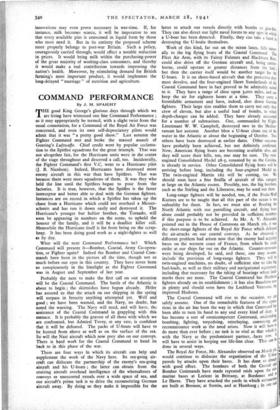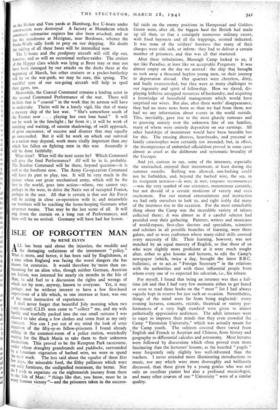COMMAND PERFORMANCE
By J. M. SPAIGHT
THE good King George's glorious days through which we are living have witnessed one fine Command Performance ; so it may appropriately be termed, with a slight twist from the usual connotation, for a Command of the Royal Air Force was concerned, and even its own self-depreciatory pilots would admit that it was " a pretty good show." Last autumn the Fighter Command met and broke the massed assault of Goering's Luftwaffe. Chief credit went by popular acclama- tion to the Spitfire squadrons for the great triumph. That was not altogether fair, for the Hurricane units were in the centre of the stage throughout and deserved a call, too. Incidentally, the Fighter Command's first V.C. went to a Hurricane pilot (J. B. Nicolson). Indeed, Hurricanes have destroyed more enemy aircraft in this war than have Spitfires. That was because there were more squadrons of them. It was they who held the line until the Spitfires began to pour from the factories. It is true, however, that the Spitfire is the faster interceptor and better able to deal with the German fighters. Instances are on record in which a Spitfire has taken up the • chase from a Hurricane which could not overhaul a Messer- schmitt and has run it down easily and destroyed it. The Hurricane's younger but heftier brother, the Tornado, will soon be appearing in numbers on the scene, to uphold the honour of the family, and it will be a deadlier killer still. Meanwhile the Hurricane itself is far from being on the scrap- heap. It has been doing good work as a night-fighter as well as by day.
What will the next Command Performance be? Which Command will present it—Bomber, Coastal, Army Co-opera- tion, or Fighter again? Indeed the Bomber and Coastal Com- mands have been in the picture all the time, though not so much before our eyes in this country. They have never been so conspicuously in the limelight as the Fighter Command was in August and September of .last year.
Probably the next to make the first call on our attention will be the Coastal Command. The battle of the Atlantic is about to begin ; the skirmishes have begun already. Hitler has assured us that the attack on our shipping in the spring will surpass in ferocity anything attempted yet. Well and good ; we have been warned, and the Navy, no doubt, has noted the warning. The Navy will need, and will have, the assistance of the Coastal Command in grappling with this menace. It is probably the gravest of all those with 'which we are confronted, but Admiral Tovey, at any rate, is confident that it will be defeated. The packs of U-boats will have to be hunted from above as well as on the surface of the sea. So will the Nazi aircraft which now prey also on our convoys. There is hard work for the Coastal Command to bend its back to in this phase of the war.
There are four ways in which its aircraft can help and supplement the work of the Navy here. Its sea-going air- craft can dislocate the partnership of the enemy's sea-going aircraft and his U-boats ; the latter can obtain from the cruising aircraft overhead intelligence of the whereabouts of convoys or unescorted vessels over a wide space of sea, and our aircraft's prime task is to drive the reconnoitring German aircraft away. By doing so they make it impossible for the latter to attack our vessels directly with bombs or gun-fire They can also direct our light naval forces to any spot in which. a U-boat has been detected. Finally, they can take a hand in destroying the U-boats themselves.
Work of this kind, far out on the ocean lanes, falls natur- ally to the big flying boats of the Coastal Command.
Fleet Fleet Air Arm, with its Fairey Fulmars and Blackburn Rocs, could also drive off the German aircraft and, being carrier- borne, could operate at greater distances from the land. but then the carrier itself would be another target for the U-boats. It is on shore-based aircraft that the protective duo must devolve, and the four-engined Short Sunderlands of the Coastal Command have in fact proved to be admirably suited to it. They have a range of close upon 3,000 miles, and can keep the air for eighteen hours at a time. They carry a formidable armament and have, indeed, shot down German fighters. Their large size enables them to carry not only rhea crew of eleven, but also a useful load of bombs, to which depth-charges can be added. They have already accounted for a number of submarines. One, commanded by Flight. Lieutenant W. W. Campbell, destroyed two in the Mediter- ranean last autumn. Another blew a U-boat clean out of the water in the Atlantic at about the beginning of October. Two others have been destroyed at earlier dates. Other successes have probably been achieved, but not definitely confirmed. Now, American flying boats are becoming available also, and they will score their kills, too, one may be sure. The twin- engined Consolidated Model 28-5, renamed by us the Catalina, is already in service. Other Consolidated flyirig boats will be arriving before long, including the four-engined Model 29. The twin-engined Martin 162 will be corning, too. We should soon , have a fine flotilla of aircraft of this categon at large on the Atlantic routes. Possibly, too, the big bombers. such as the Stirling and the Liberator, may be used out there.
Long-range fighters will be needed, too, if the Focke-Wulf Kuriers are to be taught that all this part of the ocean is too unhealthy for them. In fact, we must aim at flooding the North Atlantic with our patrolling aircraft, and flying boats alone could probably not be provided in sufficient numbers if this purpose is to be achieved. As Mr. A. V. Alexander pointed out in the House of Commons on March 5th. it was the short-range fighters of the Royal Air Force which defeated the air-attacks on our coastal convoys. As he observed. a different problem had arisen now that the enemy had acquired bases on the western coast of France, from which he could strike at our ships far out on the Atlantic. Counter-measures were being developed, he said, and these, one may assume. include the provision of long-range fighters. They Will be twin-engined machines, no doubt, of sufficient size to take big fuel-loads, as well as their military and navigational equipment. including that necessary for the taking of bearings where land- marks there are none. The Coastal Command has Blenheim fighters already on its establishment ; it has also Beauforts now in plenty and should soon have the Lockheed Venturas, the improved Hudsons.
The Coastal Command will rise to the occasion. we call safely assume. One of the remarkable features of the opera- tions in the air has been the way in which that Command 10 been able to turn its hand to any and every kind of duty. .11 has become a sort of omnicompetent Command, undertakg bombing, fighting, torpedoing, minelaying, convoying and reconnaissance work as the need arises. Now it will have to do more than ever before ; no task is so vital as that Much it' with the Navy as the predominant partner, faces now. It will have to assist in keeping our life-line clear. That can be done in several ways.
The Royal Air Force, Mr. Alexander observed on March 5 would continue to dislocate the organisation of the U-b4 patrols by attacks upon their bases. It has done so alreadv_,- with good effect. The bombers of both the Coastal Bomber Conimands have made repeated raids upon the s0.81 marine bases at Lorient in Brittany, at Bordeaux and Le Havre. They have attacked the yards in which submaral are built at Bremen; at Stettin, and at Hamburg ; in one ry" on the Blolun and Voss yards at Hamburg, five U-boats under construction were destroyed A factory at Mannheim which constructs submarine engines has also been attacked, and so has the aerodrome at Merignac, near Bordeaux, whence the Focke-Wulfs sally forth to prey on our shipping. No doubt the raiding of all these bases will be intensified now. The U-boats and the predatory aircraft will still slip out, however, and so will an occasional surface-raider. The cruiser of the Hipper class which was lying at Brest may or may not have been damaged by our attacks on the docks there at the beginning of March, but other cruisers or a pocket-battleship will be on the war-path, we may be sure, this spring. The watchful eyes of our sea-going aircraft will help to spoil their game, too.
Meanwhile, the Coastal Command remains a leading actor in this second Command Performance of the war. There will be little that is "_coastal " in the work that its airmen will have to undertake. Theirs. will be a lonely vigil, like that of many a mystery ship of the last war. " She's somewhere south of the Fastnet now . . . playing her own lone hand." It will not be work in the limelight ; far from it ; it will be work of watching and waiting, of unseen shadowing, of swift approach, of grim encounter, of success and disaster that may equally go unrecorded. But it will be work on which our survival as a nation may depend, work more vitally important than any which has fallen on fighting men in this war. Assuredly it will be done faithfully.
What then? What will the next scene be? Which Command will give the final Performance? All will be in it, probably. The Bomber Command will be there, beyond question—it is well to the forefront now. The Army Co-operation Cominand will have its part to play, too. It will be very much in the picture when our great mechanised army, which will be the best in the world, goes into action—where, one cannot say; perhaps in the west, to drive the Nazis out of occupied France, perhaps in the east. All that is certain is that our Air Force will be acting in close co-operation with it; and meanwhile our bombers will be teaching the home-keeping Germans what air-power means. That may be the last scene of all. It will ring down the curtain on a long run of Performances, and there will be no revival. Germany will have had her lesson.































 Previous page
Previous page